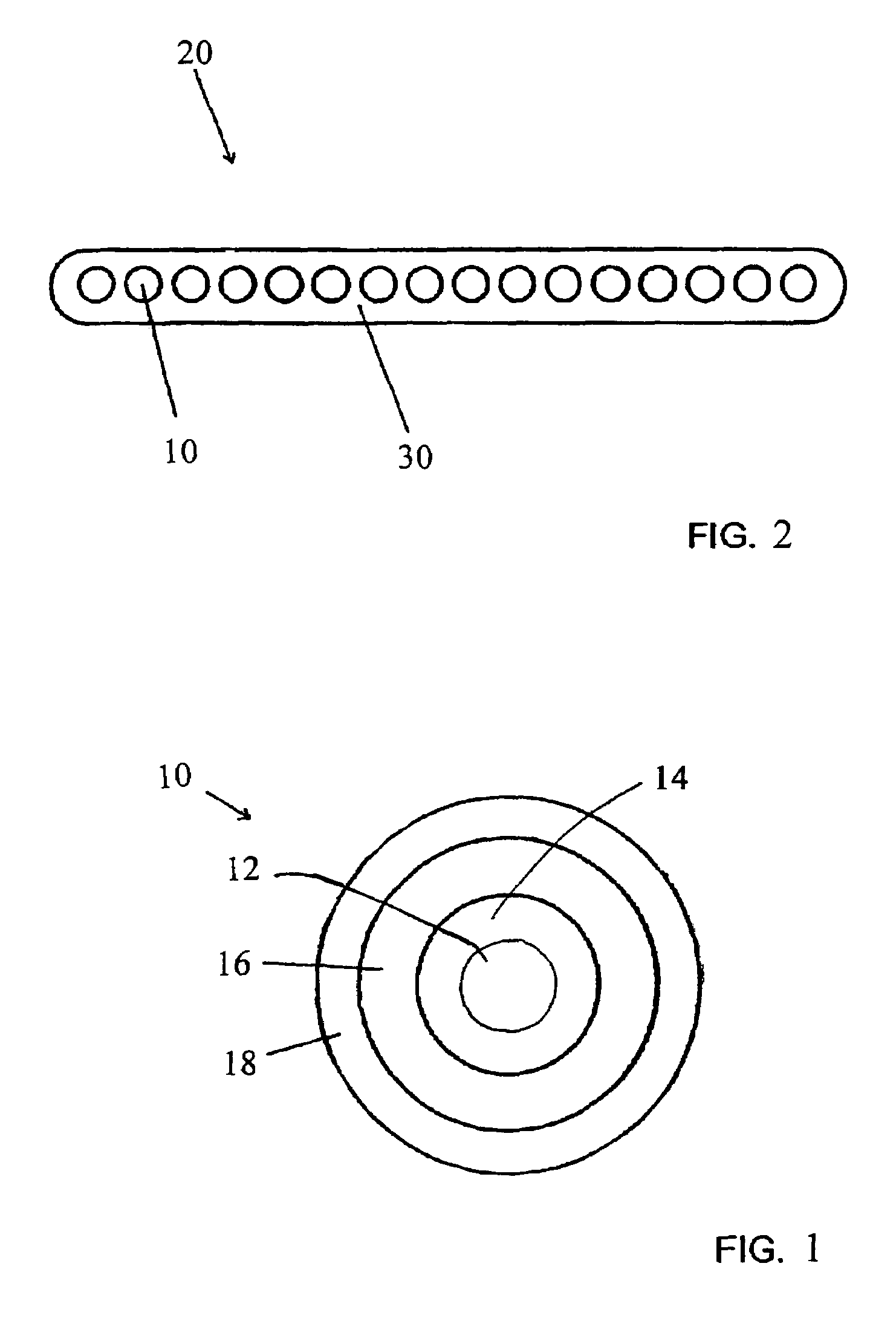Fast curing primary optical fiber coatings
a technology of optical fiber and coating, applied in the field of optical fiber, can solve the problems of poor performance of prior coatings of optical fibers under such adverse conditions, inefficient signal transmission, direct exposure of fibers used in local networks to harsh conditions, etc., and achieves excellent polymerization rate, low glass transition temperature (tg), and high refractive index.
- Summary
- Abstract
- Description
- Claims
- Application Information
AI Technical Summary
Benefits of technology
Problems solved by technology
Method used
Image
Examples
example 1
Preparation of Primary Coating Compositions
[0089]All materials were used as received. As used below, the sources of various components of the coating compositions are identified as follows:[0090]Sartomer—Sartomer Company (West Chester, Pa.);[0091]Bomar—Bomar Specialties Company (Winsted, Conn.);[0092]Ciba—Ciba Specialty Chemicals (Hawthorne, N.Y.);[0093]Cognis—Cognis Corporation (Ambler, Pa.);[0094]Dow—Dow Chemical Co. (Midland, Mich.);[0095]ISP—ISP Technologies (Waterford, Mich.);[0096]Aldrich—Sigma-Aldrich (St. Louis, Mo.); and[0097]Gelest—Gelest, Incorporated (Morrisville, Pa.)
Control Composition A[0098]BR3741 (Bomar), urethane acrylate oligomer, 52 wt %[0099]Photomer 4003 (Cognis), ethoxylated nonyl phenol acrylate monomer, 41.5 wt %[0100]Tone M-100 (Dow), caprolactone acrylate, 5 wt %[0101]Irgacure 819 (Ciba), photoinitiator, 1.5 wt %[0102]Irganox 1035 (Ciba), antioxidant, 1 pph[0103]Pentaerythritol tetrakis(3-mercaptopropionate) (Aldrich), 0.032 pph[0104]Acryloxypropyltrimetho...
example 2
Testing of Cured Products of the Primary Coating Compositions
[0134]Samples of the coatings were applied to a glass surface and then cured by exposing the coatings to a dose level of about 1.0 J / cm2 using a 600 watt / in D bulb (available from Fusion UV Systems, Inc. (Gaithersburg, Md.). The resulting coating materials were then tested for the following physical properties: Young's modulus and glass transition temperature (Tg).
[0135]The tensile (Young's) modulus value is a measure of the stiffness of a material and is calculated from the initial slope of a stress vs. strain curve. As used herein, the Young's modulus of a primary coating is measured using a tensile testing instrument (e.g., a Sintech MTS Tensile Tester, or an Instron Universal Material Test System) on a cured sample of material shaped as a film between about 0.003″ (76 μm) and 0.004″ (102 μm) in thickness and about 1.3 cm in width, with a gauge length of 5.1 cm, and a test speed of 2.5 cm / min. The slope of the resulting...
example 3
Preparation of Optical Fibers with Primary Coatings
[0139]Optical fibers will be prepared using the above-identified primary coating materials and suitable secondary coating materials according to known procedures. A primary coating material will be applied to the fiber and cured, after which a secondary coating material will be applied and cured to drawn glass fibers subsequent to cooling. The glass fiber, having a diameter of about 125 μm, will be introduced into a container of one of the primary compositions listed in Example 1. As the coated fiber is removed from the container, the thickness of the primary coating composition will be adjusted to about 32.5 μm by passing the coated fiber through a die. The coated fiber will then be drawn through a second coating container holding a secondary coating composition. As the coated fiber is removed from the second container, the thickness of the secondary coating composition will be adjusted to about 27.5 μm by passing the coated fiber ...
PUM
| Property | Measurement | Unit |
|---|---|---|
| weight percent | aaaaa | aaaaa |
| glass transition temperature | aaaaa | aaaaa |
| glass transition temperature | aaaaa | aaaaa |
Abstract
Description
Claims
Application Information
 Login to View More
Login to View More - R&D
- Intellectual Property
- Life Sciences
- Materials
- Tech Scout
- Unparalleled Data Quality
- Higher Quality Content
- 60% Fewer Hallucinations
Browse by: Latest US Patents, China's latest patents, Technical Efficacy Thesaurus, Application Domain, Technology Topic, Popular Technical Reports.
© 2025 PatSnap. All rights reserved.Legal|Privacy policy|Modern Slavery Act Transparency Statement|Sitemap|About US| Contact US: help@patsnap.com



